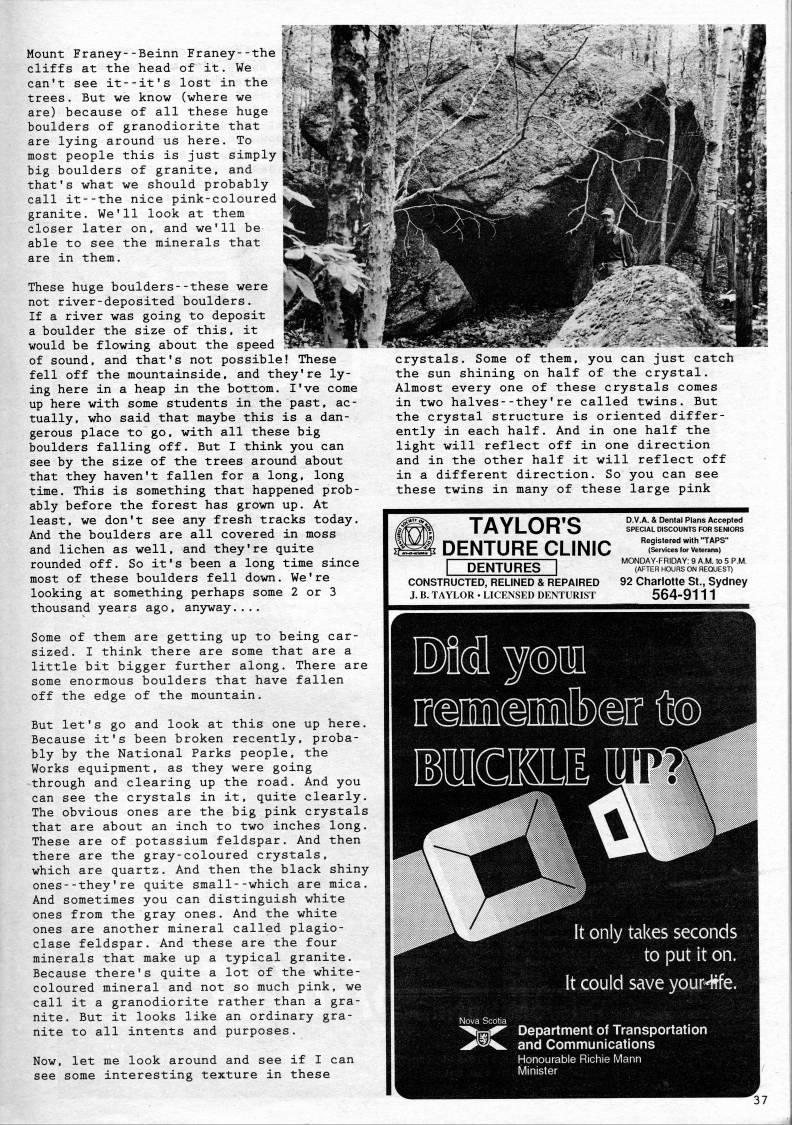Page 37 - A Geology Walk up the Clyburn Valley
Published by Ronald Caplan on 1994/8/1 (241 reads)Mount Franey--Beinn Franey--the cliffs at the head of it. We can't see it--it's lost in the trees. But we know (where we are) because of all these huge boulders of granodiorite that are lying around us here. To most people this is just simply big boulders of granite, and that's what we should probably call it--the nice pink-coloured granite. We'll look at them closer later on, and we'll be able to see the minerals that are in them. These huge boulders--these were not river-deposited boulders. If a river was going to deposit a boulder the size of this, it would be flowing about the speed of sound, and that's not possible! These fell off the mountainside, and they're ly? ing here in a heap in the bottom. I've come up here with some students in the past, ac? tually, who said that maybe this is a dan? gerous place to go, with all these big boulders falling off. But I think you can see by the size of the trees around about that they haven't fallen for a long, long time. This is something that happened prob? ably before the forest has grown up. At least, we don't see any fresh tracks today. And the boulders are all covered in moss and lichen as well, and they're quite rounded off. So it's been a long time since most of these boulders fell down. We're looking at something perhaps some 2 or 3 thousand years ago, anjrway. . . . Some of them are getting up to being car- sized. I think there are some that are a little bit bigger further along. There are some enormous boulders that have fallen off the edge of the mountain. But let's go and look at this one up here. Because it's been broken recently, proba? bly by the National Parks people, the Works equipment, as they were going through and clearing up the road. And you can see the crystals in it, quite clearly. The obvious ones are the big pink crystals that are about an inch to two inches long. These are of potassium feldspar. And then there are the gray-coloured crystals, which are quartz. And then the black shiny ones--they're quite small--which are mica. And sometimes you can distinguish white ones from the gray ones. And the white ones are another mineral called plagio- clase feldspar. And these are the four minerals that make up a typical granite. Because there's quite a lot of the white- coloured mineral and not so much pink, we call it a granodiorite rather than a gra? nite. But it looks like an ordinary gra? nite to all intents and purposes. Now, let me look around and see if I can see some interesting texture in these crystals. Some of them, you can just catch the sun shining on half of the crystal. Almost every one of these crystals comes in two halves--they're called twins. But the crystal structure is oriented differ? ently in each half. And in one half the light will reflect off in one direction and in the other half it will reflect off in a different direction. So you can see these twins in many of these large pink TAYLOR'S ' DENTURE CLINIC I DENTURES ] CONSTRUCTED, RELINED & REPAIRED J. B. TAYLOR • LICENSED DENTURIST D.V.A. & Dental Plans Accepted SPECIAL DISCOUNTS FOR SENIORS Registered with "TAPS" (Services for Veterans) MONDAY-FRIDAY: 9 A.M. to 5 P.M. (AFTER HOURS ON REQUEST) 92 Charlotte St., Sydney 564-9111 It only takes seconds to put it on. It could save your-We. 'r',. Department of Transportation ''' and Communications
Adobe Acrobat Reader is required to the PDF version of this content. Click here to download and install the Acrobat plugin





